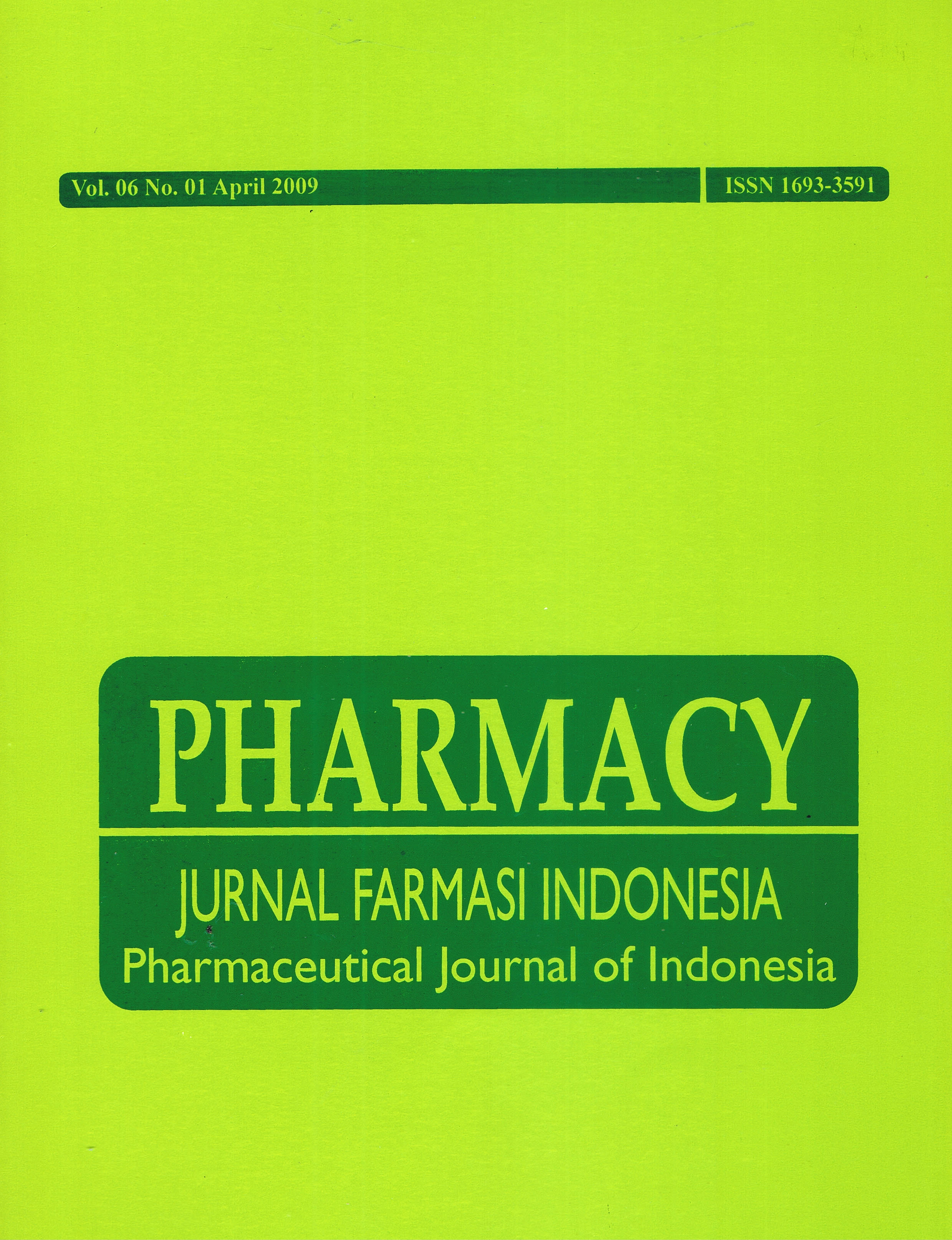PENGARUH KOMBINASI AVICEL PH 101 DAN AMILUM MANIHOT SEBAGAI BAHAN PENGHANCUR TERHADAP SIFAT FISIS TABLET PARASETAMOL
DOI:
https://doi.org/10.30595/pharmacy.v6i01.400Abstract
ABSTRAK Penelitian ini bertujuan untuk mengetahui pengaruh Avicel PH 101, amilum manihot, dan kombinasi keduanya sebagai bahan penghancur terhadap sifat fisis tablet parasetamol. Tiga formula tablet parasetamol dibuat dengan bahan penghancur yang berbeda dan dibuat dengan metode granulasi basah. Formula I menggunakan bahan penghancur Avicel PH 101 100%. Formula II dengan amilum 100% dan formula III menggunakan kombinasi Avicel PH 101 50% dan amilum manihot 50%. Granul yang telah dibuat diuji kecepatan alirnya, dan tablet diuji sifat fisisnya meliputi keseragaman bobot, kekerasan, kerapuhan dan waktu hancur. Formula I dengan bahan penghancur Avicel PH 101 memberikan kekerasan tablet yang paling besar (6,28 kg), kerapuhan paling kecil (0,6279 %) dan waktu hancur paling cepat (3,03 menit). Tablet formula II dengan bahan penghancur amilum memberikan kekerasan tablet yang paling kecil (5,66 kg), kerapuhan terbesar (0,8513 %) dan waktu hancur paling lambat (6,06 menit). Sedangkan formula III, dengan bahan penghancur kombinasi Avicel PH 101 dan amilum memberikan kekerasan tablet lebih besar (6,08 kg), kerapuhan lebih kecil (0,6985 %) dan waktu hancur paling cepat (3,89 menit) dari formula II. Kata kunci : Avicel PH 101, amilum manihot, parasetamol ABSTRACT The aims of this study was to find out the influence of Avicel PH 101, tapioca starch and the combinationboth of Avicel PH 101 and tapioca starch as a disintegrant to physical properties of acetaminophen tablets. Three formula were prepared containingof different disintegrant in each formula, and tablets were made by wet granulation method.Formula I with disintegrant Avicel PH 101 100%. Formula II with disintegrant amilum starch 100%, and formula III with combination Avicel PH 101 50% and tapioca starch 50%. Flow rates of the granule were tested and physical propertiesof tablets includes of weight uniformity, hardness, friability, and disintegrationtime were tested. Formula I containing Avicel PH 101 as a disintegrant produced hardest tablets (6.28 kg), smallest friability (0.6279 %), and fastest disintegration time (3.03 minutes). Tablets formula II containing tapioca strach as a disintegrant produced softest tablets (5.66 kg), highest friability (0.8513 %), and slowest disintegration time (6.06 minutes).While formula III containing Avicel PH 101 and tapioca strach as disintegrant produced harder tablets (6.08 kg), smaller friability (0.6985%), and faster disintegration time (3.89 minutes) than formula II. Keywords : Avicel PH 101, tapioca strach, acetaminophen.References
Achmad, G.N.V. dan Widjaja, B. 2005. Pengaruh Prosentase Fines terhadap Kualitas Tablet Parasetamol. Majalah Farmasi Airlangga. Volume 5 Nomor 2 Agustus 2005.
Agoes, G. 2006. Pengembangan Sediaan Farmasi. Bandung: Penerbit ITB.
Ansel, H.C. 1989. Pengantar Bentuk Sediaan Farmasi (Terjemahan). Farida Ibrahim, Edisi Keempat. Jakarta: UI Press.
Bandelin, F.J. 1980. Compressed Tablets by Wet Granulation. Dalam Lieberman H.A, Lachman, L., and Schartz, J.B. (Eds). Pharmecutical Dosage Form Tablet Vol.I Marcel Dekker, New York.
Depkes RI. 1979. Farmakope Indonesia, Edisi III. Jakarta: Dirjen POM Departemen Kesehatan Republik Indonesia.
_______. 1995. Farmakope Indonesia, Edisi IV. Jakarta: Dirjen POM Departemen Kesehatan Republik Indonesia.
Lachman, L., Lieberman, H.A. dan Kanig, J.L. 1994. Teori dan Praktek Farmasi Industri (Terjemahan). Siti Suyatmi, Edisi ketiga Jilid II. Jakarta: Indonesia University Press.
Siswanto, A. dan Sugijanto, L. 2003. Upaya Pembuatan Kaplet Ekstrak Belanda (Guazumae ulmifolia Lamk), Temu Giring (Curcuma heyneana Val), Kunyit (Curcuma domestica Val.) dan Meniran (Philantus niruri L.). Pharmacy. Volume 01 Nomor 02.
Sulaiman, T.N.S. 2007. Teknologi danFormulasi Sediaan Tablet. Yogyakarta: Laboratorium Teknologi Farmasi Fakultas Farmasi Universitas Gadjah Mada.
Downloads
Published
How to Cite
Issue
Section
License
Authors who publish with this journal agree to the following terms:
- Authors retain copyright and grant the journal right of first publication with the work simultaneously licensed under a Creative Commons Attribution 4.0 International License that allows others to share the work with an acknowledgement of the work's authorship and initial publication in this journal.
- Authors are able to enter into separate, additional contractual arrangements for the non-exclusive distribution of the journal's published version of the work (e.g., post it to an institutional repository or publish it in a book), with an acknowledgement of its initial publication in this journal.
- Authors are permitted and encouraged to post their work online (e.g., in institutional repositories or on their website) prior to and during the submission process, as it can lead to productive exchanges, as well as earlier and greater citation of published work (See The Effect of Open Access).






